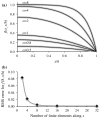Computational modeling of chemical reactions and interstitial growth and remodeling involving charged solutes and solid-bound molecules
- PMID: 24558059
- PMCID: PMC4141041
- DOI: 10.1007/s10237-014-0560-1
Computational modeling of chemical reactions and interstitial growth and remodeling involving charged solutes and solid-bound molecules
Abstract
Mechanobiological processes are rooted in mechanics and chemistry, and such processes may be modeled in a framework that couples their governing equations starting from fundamental principles. In many biological applications, the reactants and products of chemical reactions may be electrically charged, and these charge effects may produce driving forces and constraints that significantly influence outcomes. In this study, a novel formulation and computational implementation are presented for modeling chemical reactions in biological tissues that involve charged solutes and solid-bound molecules within a deformable porous hydrated solid matrix, coupling mechanics with chemistry while accounting for electric charges. The deposition or removal of solid-bound molecules contributes to the growth and remodeling of the solid matrix; in particular, volumetric growth may be driven by Donnan osmotic swelling, resulting from charged molecular species fixed to the solid matrix. This formulation incorporates the state of strain as a state variable in the production rate of chemical reactions, explicitly tying chemistry with mechanics for the purpose of modeling mechanobiology. To achieve these objectives, this treatment identifies the specific theoretical and computational challenges faced in modeling complex systems of interacting neutral and charged constituents while accommodating any number of simultaneous reactions where reactants and products may be modeled explicitly or implicitly. Several finite element verification problems are shown to agree with closed-form analytical solutions. An illustrative tissue engineering analysis demonstrates tissue growth and swelling resulting from the deposition of chondroitin sulfate, a charged solid-bound molecular species. This implementation is released in the open-source program FEBio ( www.febio.org ). The availability of this framework may be particularly beneficial to optimizing tissue engineering culture systems by examining the influence of nutrient availability on the evolution of inhomogeneous tissue composition and mechanical properties, the evolution of construct dimensions with growth, the influence of solute and solid matrix electric charge on the transport of cytokines, the influence of binding kinetics on transport, the influence of loading on binding kinetics, and the differential growth response to dynamically loaded versus free-swelling culture conditions.
Figures






References
-
- Ateshian GA, Weiss JA. Finite element modeling of solutes in hydrated deformable biological tissues. Springer; Berlin: 2013. Computer models in biomechanics.
Publication types
MeSH terms
Substances
Grants and funding
LinkOut - more resources
Full Text Sources
Other Literature Sources

